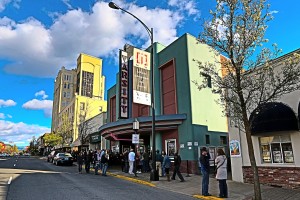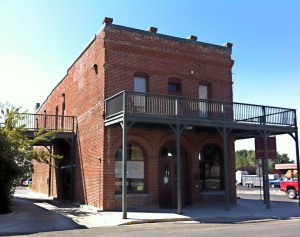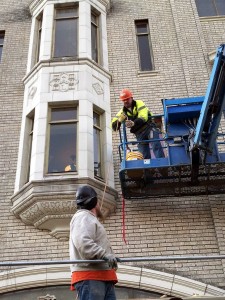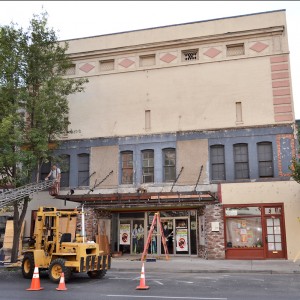The most important thing we can do to save more historic places and bring Oregon’s historic downtowns back to life is to PASS THE REVITALIZE MAIN STREET ACT
 Many of Oregon’s traditional downtowns are at a tipping point, half-empty, with their historic facades in urgent need of repair and restoration.
Many of Oregon’s traditional downtowns are at a tipping point, half-empty, with their historic facades in urgent need of repair and restoration.
Thankfully, there is a small army of intrepid citizens eager to buttress foundations, re-shingle roofs, re-point brick, restore marquees, re-glaze windows, and open businesses. They see the potential to remodel upper floors into housing, transform warehouses into office lofts, convert shuttered movie theaters into arts centers, and open restaurants that showcase local produce and microbrews.
These entrepreneurs of Main Street lack just one thing: a complete financial toolset to address the high cost of restoration, code upgrades, and seismic retrofitting. For four years Restore Oregon has been calling for a state incentive and on February 2nd the Revitalize Main Street Act was introduced by the Senate Finance Committee as SB 565.
This bill would create a state Historic Rehabilitation Fund to provide a 25% rebate on the costs of fixing up historic commercial buildings. If passed, the bill would literally transform scores of Oregon’s traditional downtowns from Astoria to Burns, Coos Bay to Enterprise.
Here’s a countdown of 10 great reasons we must seize the opportunity to invest in the future of our historic downtowns.
- ATTRACT TOURISTS. Restored, vibrant historic downtowns give tourists a reason to pull off the highway to shop, dine, and spend the night at local establishments. According to industry research, cultural and heritage tourism is the fastest growing segment of the tourism market with 83% of travelers to Oregon describing themselves as such.
- REUSE INFRASTRUCTURE. When downtowns are restored and reactivated, cities can leverage existing streets, transit, water, sewer, and other services instead of funding costly new expansion of services.
- REAL SUSTAINABILITY. It’s far greener to reuse an existing building than to demolish and replace it. According to the Preservation GreenLab, it can take up to 80 years to generate enough energy savings to pay for the energy lost during demolition and construction of a new building – even the most energy efficient. Furthermore, simple energy retrofits of older commercial buildings result in an energy savings of 27% to 59%.
- SEISMIC SAFETY. Everyone keeps talking about the Big One, but seismic upgrades are expensive and won’t happen by magic! The Historic Rehabilitation Fund offsets costs for earthquake retrofitting, ADA, and fire code compliance so buildings are safer and empty upper stories can be put back into service.
- LOCAL COFFERS. When buildings are restored, their value goes up and they employ more people, which in turn generates more revenue for state and local governments to pay for schools and services. Within a decade, projects enabled by the Fund would result in a $9 million annual increase in local property taxes. Restored buildings also have a positive “halo” effect on neighboring businesses and property values, leading to more revitalization and new construction.
- PROUD HERITAGE. Our historic Main Streets are cultural assets that tell the story of where we came from and who we are. They provide an authentic, unique identity that you can’t find in a strip mall.
- PROVEN RESULTS. Thirty-five other states invest State dollars to close the development gap that currently keeps many of Oregon’s historic buildings from being restored and reused. An economic analysis demonstrates that the Historic Rehabilitation Fund would generate a four-fold increase in the number of certified rehabilitation projects in Oregon.
- MORE MONEY. By implementing a state Historic Rehab Fund, Oregon will snag more dollars from the Feds – over $13M more per year according to an economic study by EcoNorthwest – because more projects become financially viable that will qualify for the federal Historic Tax Credit.
- LOCAL JOBS. Now is the time to create local jobs and spur redevelopment in scores of historic hotels, department stores, theaters, apartments, factories and mills from Astoria to Baker City, Portland to Coos Bay, and The Dalles to Klamath Falls. Hundreds of new jobs in construction and related services would be created per year with 75% of the economic benefit staying within the local economy.
- RIGHT, NOW. Many of Oregon’s traditional downtowns and their iconic buildings won’t last much longer without some meaningful help. We cannot afford to lose the economic heart and cultural soul or our communities. This is the single most important thing we could do to spur economic development on Oregon’s Main Streets and save more historic places.




What You Can Do:
ENDORSE. Add your name to our online petition.
DONATE. Lobbying is very expensive! Our costs are expected to exceed $70,000 and we need help funding this critical effort.
TESTIFY. Contact your state legislators and urge them to support SB 565. Legislator finders and letter templates are available (and let us know when you’ve sent your letters so we can thank you!). A legislative hearing will be held in early March.
http://www.oregon.gov/oprd/HCD/OHC/docs/travelers.pdf
http://www.preservationnation.org/information-center/sustainable-communities/green-lab/valuing-building-reuse.html#.VIn_V6TF-5J
“Economic Analysis of a State Rehabilitation Incentive Proposed for Oregon,” EcoNorthwest
“Economic Analysis of a State Rehabilitation Incentive Proposed for Oregon,” EcoNorthwest
“Economic Analysis of a State Rehabilitation Incentive Proposed for Oregon,” EcoNorthwest and http://restoreoregon.org/wp-content/uploads/2014/01/RestoreOregon_SpecialReport_RevitalizingMainStreet-Final.pdf

